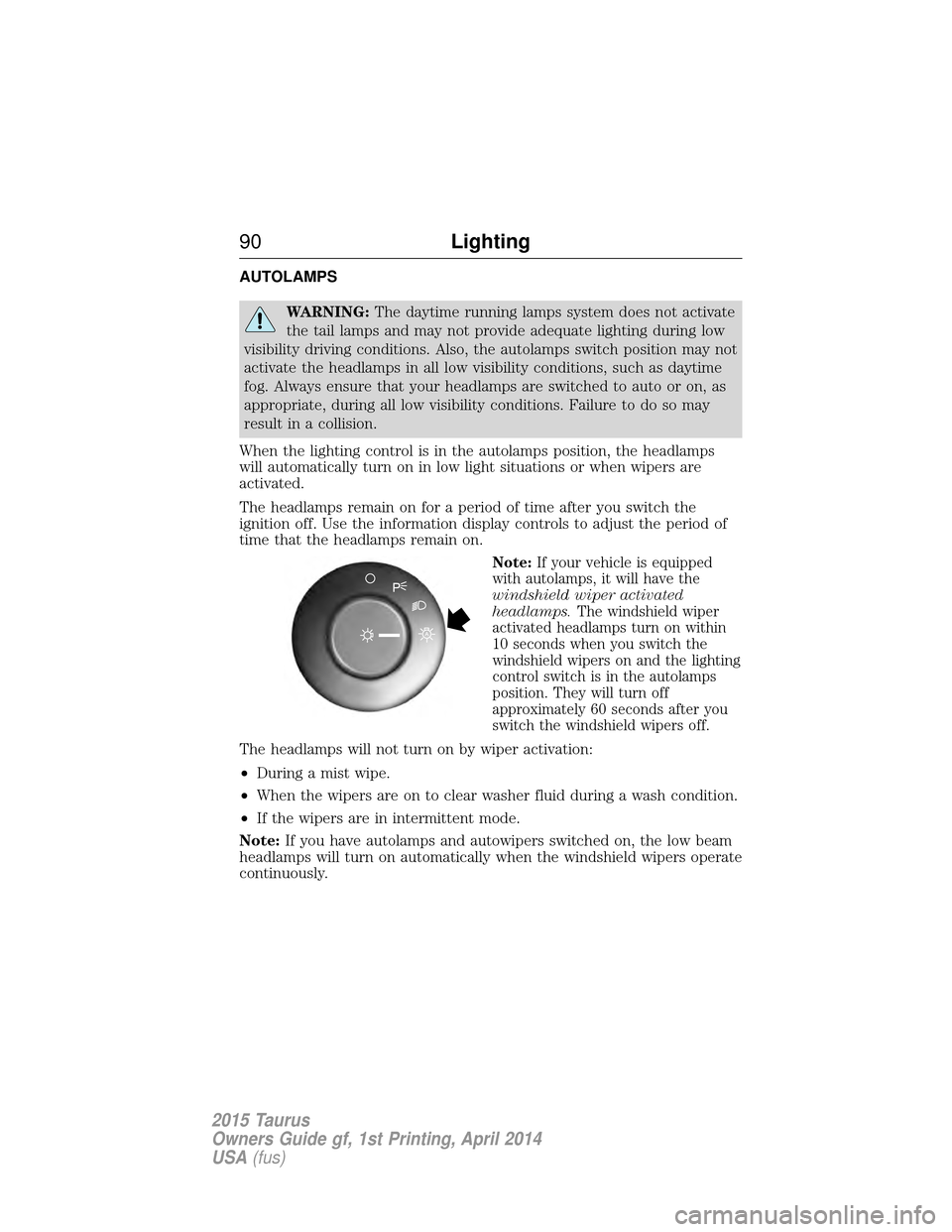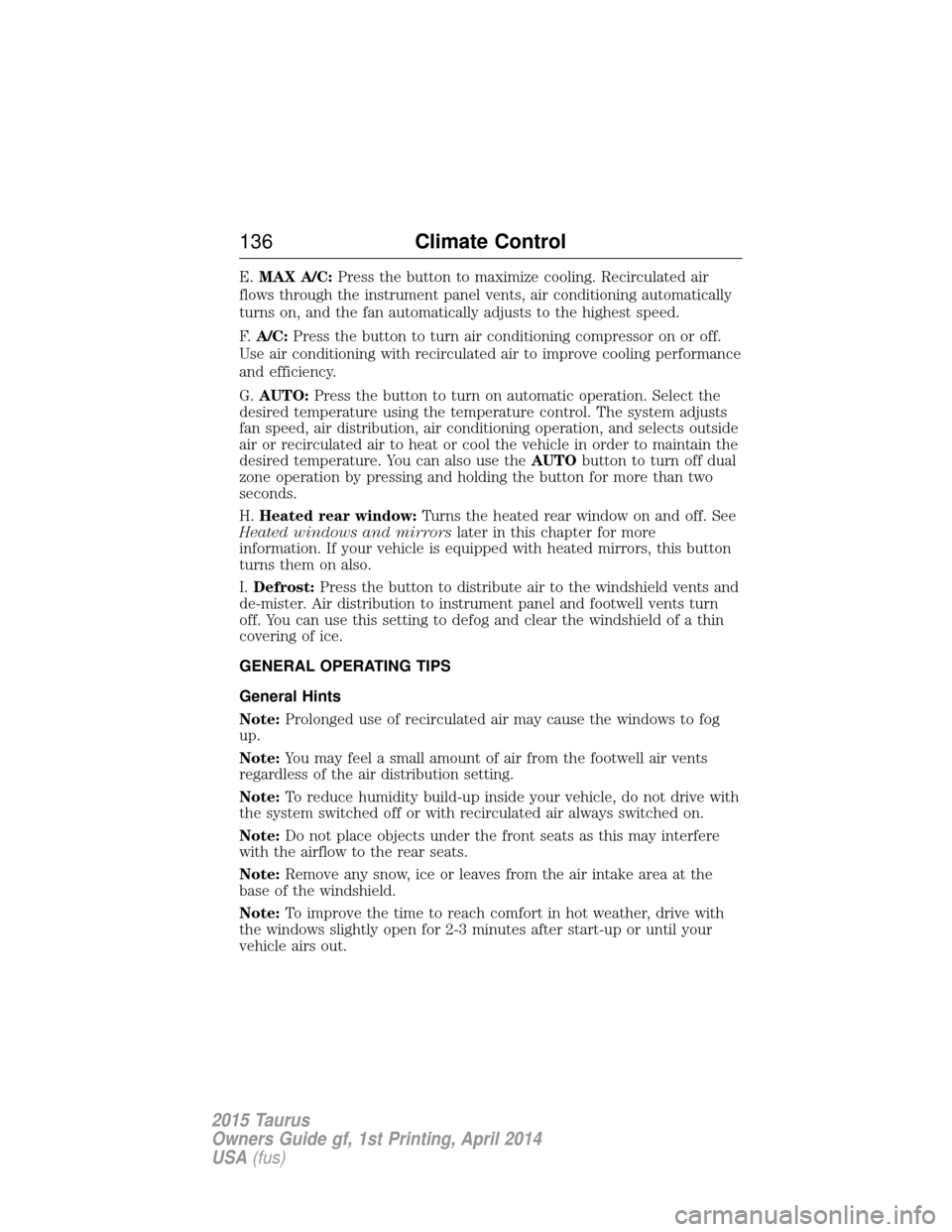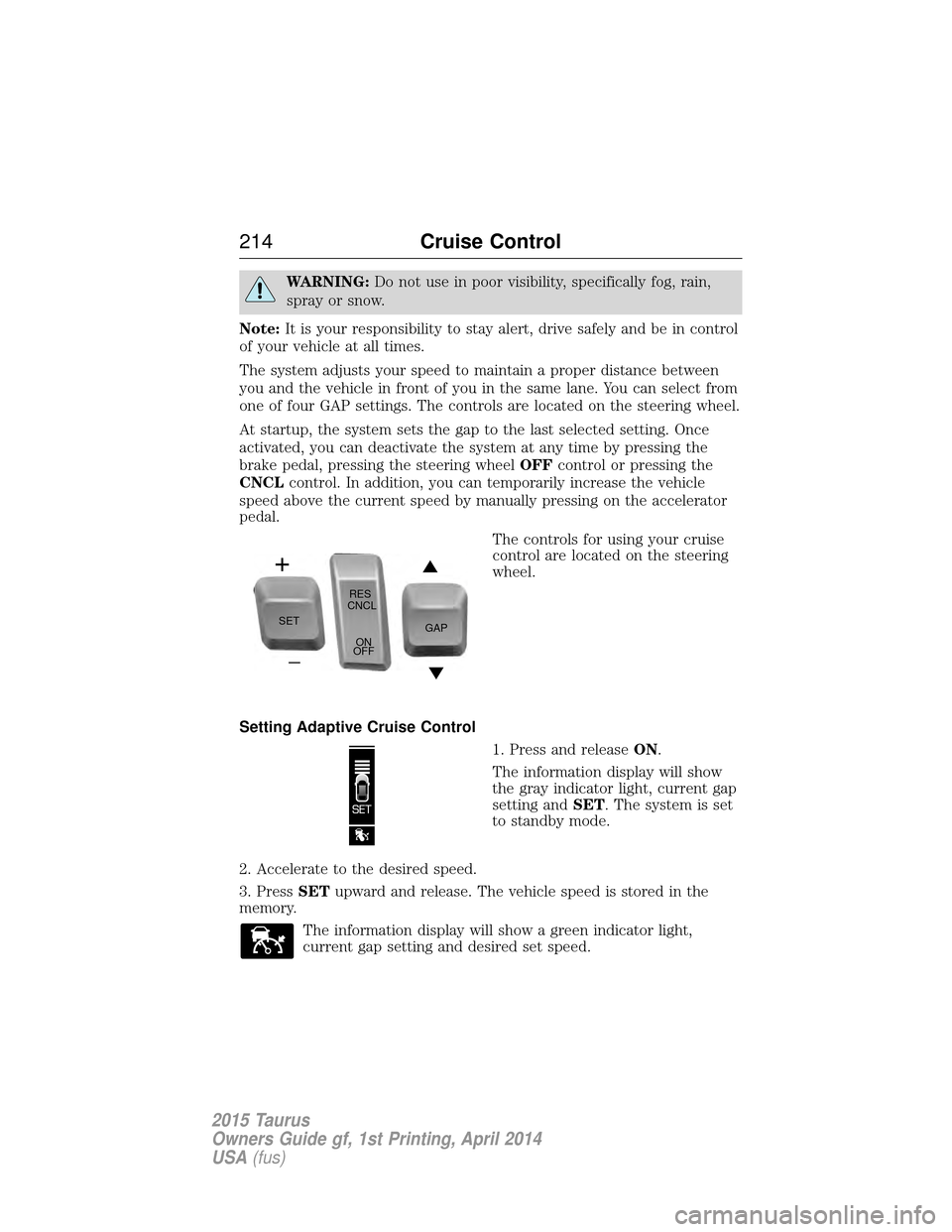Page 91 of 558

AUTOLAMPS
WARNING:The daytime running lamps system does not activate
the tail lamps and may not provide adequate lighting during low
visibility driving conditions. Also, the autolamps switch position may not
activate the headlamps in all low visibility conditions, such as daytime
fog. Always ensure that your headlamps are switched to auto or on, as
appropriate, during all low visibility conditions. Failure to do so may
result in a collision.
When the lighting control is in the autolamps position, the headlamps
will automatically turn on in low light situations or when wipers are
activated.
The headlamps remain on for a period of time after you switch the
ignition off. Use the information display controls to adjust the period of
time that the headlamps remain on.
Note: If your vehicle is equipped
with autolamps, it will have the
windshield wiper activated
headlamps. The windshield wiper
activated headlamps turn on within
10 seconds when you switch the
windshield wipers on and the lighting
control switch is in the autolamps
position. They will turn off
approximately 60 seconds after you
switch the windshield wipers off.
The headlamps will not turn on by wiper activation:
• During a mist wipe.
• When the wipers are on to clear washer fluid during a wash condition.
• If the wipers are in intermittent mode.
Note: If you have autolamps and autowipers switched on, the low beam
headlamps will turn on automatically when the windshield wipers operate
continuously.
90 Lighting
2015 Taurus
Owners Guide gf, 1st Printing, April 2014
USA(fus)
Page 94 of 558
A camera sensor is centrally mounted behind the windshield of the
vehicle, and monitors the conditions to decide when to switch the high
beams off and on.
Once the system is active the high beams will switch on if:
•The ambient light level is low enough that high beams are needed.
• There is no traffic in front of the vehicle.
• Vehicle speed is greater than 32 mph (52 km/h).
• Severe weather is not detected.
The high beams will switch off if:
• An approaching vehicle’s headlights or a preceding vehicle’s tail lamps
are detected.
• The vehicle speed falls below 27 mph (44 km/h).
• The ambient light level is high enough that high beams are not
needed.
• Severe rain, snow or fog is detected.
• The camera is blocked.
Activating the system
Switch the system on within the information display. See Information
displays.
Turn the lighting control to the
autolamps position.
Lighting93
2015 Taurus
Owners Guide gf, 1st Printing, April 2014
USA(fus)
Page 137 of 558

E.MAX A/C: Press the button to maximize cooling. Recirculated air
flows through the instrument panel vents, air conditioning automatically
turns on, and the fan automatically adjusts to the highest speed.
F. A/C: Press the button to turn air conditioning compressor on or off.
Use air conditioning with recirculated air to improve cooling performance
and efficiency.
G. AUTO: Press the button to turn on automatic operation. Select the
desired temperature using the temperature control. The system adjusts
fan speed, air distribution, air conditioning operation, and selects outside
air or recirculated air to heat or cool the vehicle in order to maintain the
desired temperature. You can also use the AUTObutton to turn off dual
zone operation by pressing and holding the button for more than two
seconds.
H. Heated rear window: Turns the heated rear window on and off. See
Heated windows and mirrors later in this chapter for more
information. If your vehicle is equipped with heated mirrors, this button
turns them on also.
I. Defrost: Press the button to distribute air to the windshield vents and
de-mister. Air distribution to instrument panel and footwell vents turn
off. You can use this setting to defog and clear the windshield of a thin
covering of ice.
GENERAL OPERATING TIPS
General Hints
Note: Prolonged use of recirculated air may cause the windows to fog
up.
Note: You may feel a small amount of air from the footwell air vents
regardless of the air distribution setting.
Note: To reduce humidity build-up inside your vehicle, do not drive with
the system switched off or with recirculated air always switched on.
Note: Do not place objects under the front seats as this may interfere
with the airflow to the rear seats.
Note: Remove any snow, ice or leaves from the air intake area at the
base of the windshield.
Note: To improve the time to reach comfort in hot weather, drive with
the windows slightly open for 2-3 minutes after start-up or until your
vehicle airs out.
136 Climate Control
2015 Taurus
Owners Guide gf, 1st Printing, April 2014
USA(fus)
Page 215 of 558

WARNING:Do not use in poor visibility, specifically fog, rain,
spray or snow.
Note: It is your responsibility to stay alert, drive safely and be in control
of your vehicle at all times.
The system adjusts your speed to maintain a proper distance between
you and the vehicle in front of you in the same lane. You can select from
one of four GAP settings. The controls are located on the steering wheel.
At startup, the system sets the gap to the last selected setting. Once
activated, you can deactivate the system at any time by pressing the
brake pedal, pressing the steering wheel OFFcontrol or pressing the
CNCL control. In addition, you can temporarily increase the vehicle
speed above the current speed by manually pressing on the accelerator
pedal.
The controls for using your cruise
control are located on the steering
wheel.
Setting Adaptive Cruise Control 1. Press and releaseON.
The information display will show
the gray indicator light, current gap
setting and SET. The system is set
to standby mode.
2. Accelerate to the desired speed.
3. Press SETupward and release. The vehicle speed is stored in the
memory.
The information display will show a green indicator light,
current gap setting and desired set speed.
SET RES
CNCL
ON
OFF GAP
214
Cruise Control
2015 Taurus
Owners Guide gf, 1st Printing, April 2014
USA(fus)
Page 228 of 558

Troubleshooting
Why is the feature not available (line markings are gray) when Ican see the lane markings on the road?
Vehicle speed is outside the operational range of the feature
Sun is shining directly into the camera lens
Quick intentional lane change
Staying too close to the lane marking
Driving at high speeds in curves
Previous feature activation happened within the last one second
Ambiguous lane markings (mainly in construction zones)
Rapid transition from light to dark or vice versa
Sudden offset in lane markings
ABS or AdvanceTrac activation
Camera blockage due to dirt, grime, fog, frost or water on the
windshield
Driving too close to the vehicle in front of you
Transitioning between no lane markings to lane markings or vice versa
Standing water on the road
Faint lane markings (partial yellow lane markings on concrete roads)
Lane width too narrow or too wide
Camera not calibrated after a windshield replacement
When driving on tight roads or on uneven roads
Why does the vehicle not come back into the middle of the lane always, as expected, in the Aid or Aid + Alert mode?
High cross winds
Large road crown
Rough roads, grooves, shoulder drop-offs
Heavy uneven loading of the vehicle or improper tire inflation pressure
If the tires have been exchanged (including snow tires), or the
suspension has been modified
Driving Aids 227
2015 Taurus
Owners Guide gf, 1st Printing, April 2014
USA(fus)